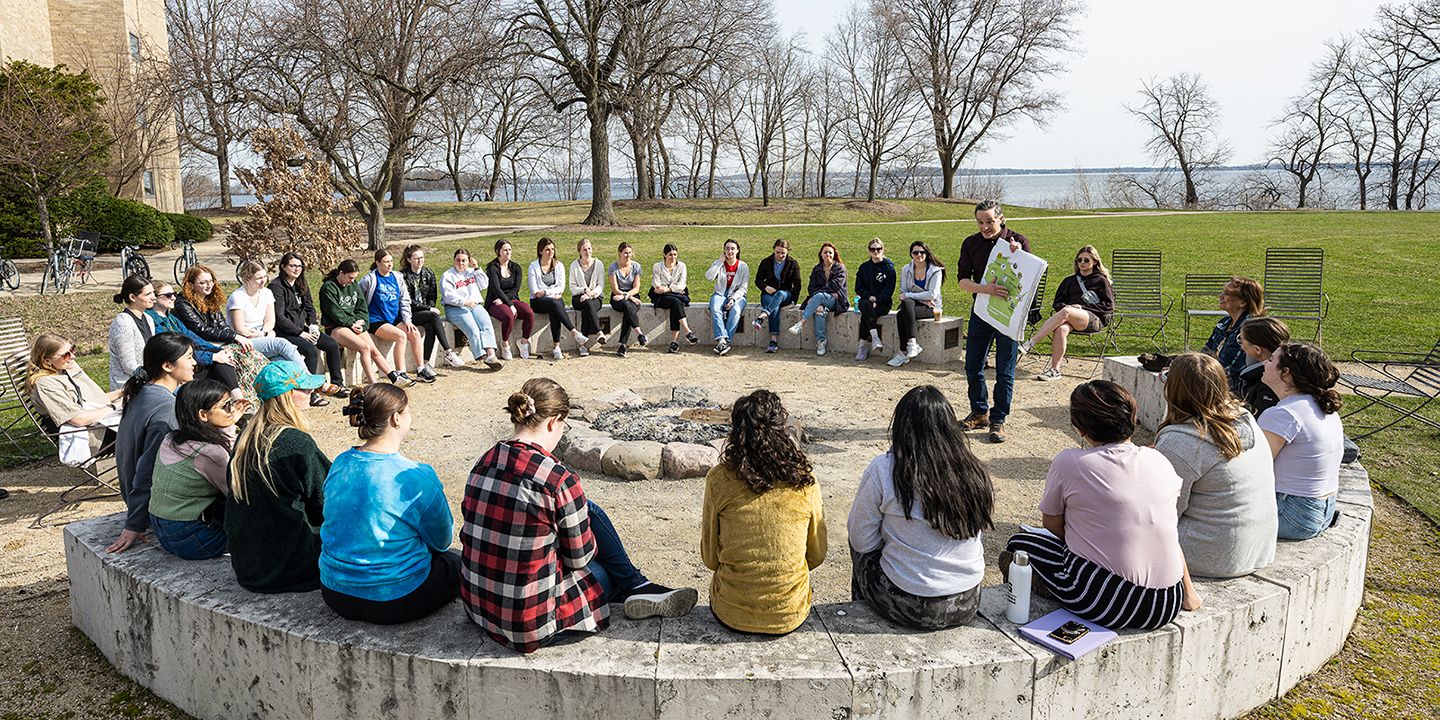
The Millennia before UW–Madison
How the First Nations Cultural Landscape Tour became a unique campus institution
Takeaways from the Tour
The story of human occupation along the southern shores of Lake Mendota begins more than 12,000 years ago — around the time the last glaciers retreated from the area.
UW–Madison occupies ancestral Ho-Chunk land, a place the Ho- Chunk Nation has called Teejop since time immemorial. In an 1832 treaty, the Ho-Chunk were forced to cede this territory.
Earthen burial mounds of Native peoples are widely distributed across campus, with several of the most prominent in the Lakeshore Nature Preserve.
Memorial Union features several “pipe of peace” design elements, and the history behind this imagery has troublesome aspects. Between the 1890s and the early 1940s, the pipe of peace ceremony drew crowds of students to Library Mall during commencement week. In this parody of Native American life, white students dressed in costumes and passed an elaborate pipe decorated with the ribbons of each graduating class.
The Tree of Peace on Observatory Hill was planted in 1988 by Mohawk elder Tekaronianeken, who remind- ed us to care for one another and for the environment.
— D.E.
Standing on the crest of Observatory Hill, UW–Madison senior Kane Funmaker x’24 invites the people around him to envision a much different view of Lake Mendota than the one in front of them.
Hundreds of years ago, Funmaker tells the group, thousands of Ho-Chunk people flourished on the land along the lakeshore. It was a thriving center for tribal resources and trade, with prosperous fishing, raised garden beds, maple tree stands for sap collecting, and nearly 1,000 effigy burial mounds.
“Imagine Ho-Chunk clan villages all over this area, their dwellings ringing Lake Mendota, which the Ho-Chunk called Waaksikhomik,” Funmaker says.
The stop was one of several that day on the First Nations Cultural Landscape Tour, a popular educational offering that began modestly two decades ago and has evolved into a campus institution. The walking tour of up to two hours examines the 12,000-plus years of human existence documented along the shores of Lake Mendota, particularly the history of the Ho-Chunk Nation, on whose ancestral land the university now sits.
Participants view the unique double-tailed water spirit burial mound near Agricultural Hall — one of dozens of mounds on campus. On another stop, they stand atop Bascom Hill and learn of the campus buildings constructed on mounds, including Bascom Hall and North Hall. And they visit more recent additions to campus, such as the fire circle at Dejope Residence Hall, with its bronze plaques representing the 11 federally recognized American Indian tribes in Wisconsin.
John Zumbrunnen, senior vice provost for academic affairs and vice provost for teaching and learning, says the tour is a deeply important learning opportunity for the campus community, one that combines expert scholarship and engaging storytelling.
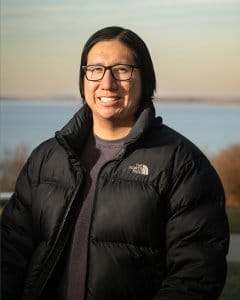
Tour guides like Funmaker explain what it’s like to be Ho-Chunk at UW–Madison.
“So many people on campus and in the community are committed to honoring the Indigenous cultures that have long called this special place home. One way to do that is by learning about the land and its history.”
It is indeed a rich history. There are more Indigenous burial mounds in a greater variety at UW–Madison than on any other university or college campus in North America, says state archaeologist Amy Rosebrough MA’96, PhD’10. “These mounds are an extremely rare resource.”
For something so embedded in the campus terrain, the tour began informally and with little fanfare. Its genesis can be traced to the hiring of Aaron Bird Bear MS’10 in 2000 as the American Indian student academic services coordinator in the College of Letters & Science. His charge was to support the academic, cultural, and social needs of American Indian, Alaska Native, and Native Hawaiian students.
But not long after arriving, Bird Bear identified a shocking problem.
“I Didn’t Ask Anyone’s Permission”
Aside from the American Indian and Indigenous Studies program, there was hardly anything related to American Indians, Alaska Natives, and Native Hawaiians visible on campus.
“I was appalled at the complete lack of infrastructure — the complete lack of commitment — to Indigenous people in any sincere way, shape, or form,” says Bird Bear, a citizen of the Mandan, Hidatsa, and Diné Nations who is enrolled in the Three Affiliated Tribes of Fort Berthold.
Bird Bear set out to change that. Along with the late Ada Deer ’57, a pioneering Native American activist and director of the UW American Indian Studies program at the time, he reactivated and cotaught American Indian Studies 150 and 151, courses that introduce students to current American Indian issues. At one of these classes, Deer invited Daniel Einstein MS’95 to give a guest lecture. Einstein, the campus historic and cultural resources manager, took the class on a walking tour of some of the campus sites with Native history, including the Ho-Chunk effigy mounds on Observatory Hill.
“I was astounded,” Bird Bear recalls. “I didn’t know that all of this history was here.”
Bird Bear took what Einstein had taught him, expanded on it, and stitched together a walking tour that “would lift the colonial veneer that obscures the Indigeneity of this space,” he says.
The result was the First Nations Cultural Landscape Tour. Bird Bear began giving tours in 2003 simply as a service to Indigenous students. He wanted them to feel a connection to the land and to know that they belonged on campus. Word spread, and soon many others were inquiring about the tour, including teachers-in-training, staff members seeking professional development, and instructors looking to expose their students to Native history.
More than 25,000 people have now taken the free tour. It’s a remarkable outcome for an idea Bird Bear says he never officially pitched to anyone. He credits then-Chancellor John Wiley MS’65, PhD’68 with giving him the confidence to launch the tour.
“He told me, ‘Women and minorities too often wait for approval to do something. That’s not how this place works. Just go do something and tell me when it works.’ ”
So that’s what Bird Bear did. “I didn’t ask anyone’s permission,” he says. “I just started giving tours.”
“This Is a Sacred Place to Me”
Until recently, almost all the tours were led by Bird Bear and Omar Poler ’07, MA’10, the Indigenous education coordinator with the Office of the Provost. The two took on the role in addition to their official university duties, fitting in tours whenever they could. Bird Bear later became the university’s first tribal relations director. He retired in 2023, which underscored the need for a different approach to the tour, one that would ensure its long-term viability.
The tour is now offered through a partnership between Campus and Visitor Relations and the Office of the Provost, putting it on firmer footing. To meet demand, the university recently increased the number of tour guides from two to nine. For the first time, some of the tour guides are UW–Madison students, and several are Ho-chunk, including Funmaker, who studies in the School of Human Ecology. This adds another compelling aspect to the experience. Participants hear directly from current students about what it is like to be Ho-Chunk at UW–Madison.
Silas Cleveland x’25, a history major, says being a tour guide is helping him explore his own complicated feelings about the treatment of Indigenous peoples in Wisconsin and at the university. He is Ho-Chunk and often weaves personal stories into the tours he leads.
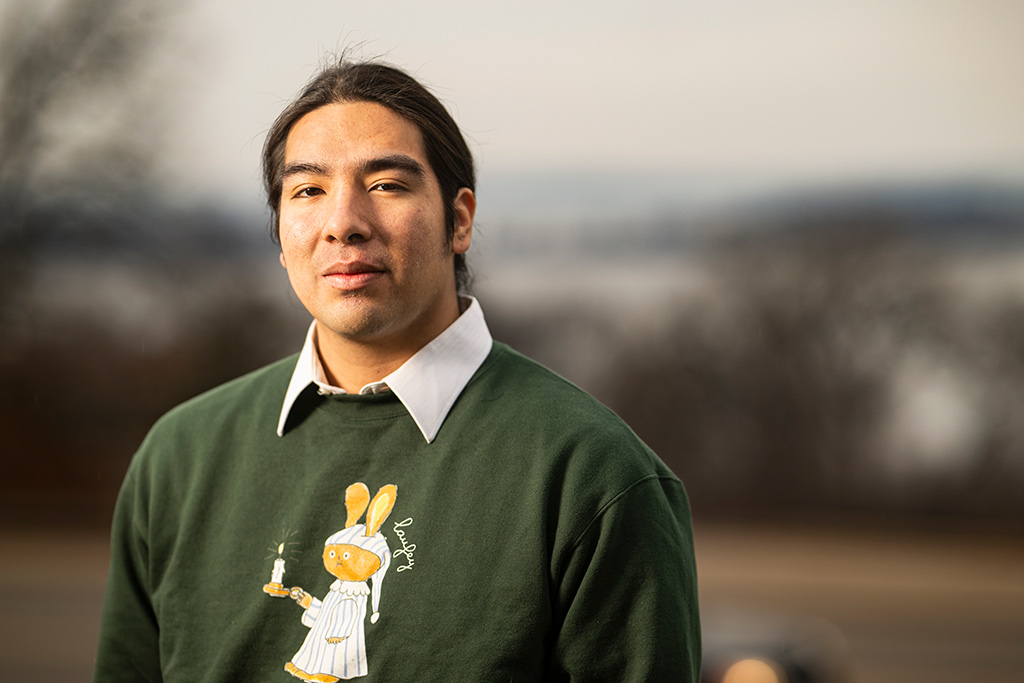
Being a tour guide helps Cleveland explore his own complicated feelings about the treatment of Indigenous peoples.
“It means the world to me to be part of these tours,” he says. “This is a sacred place to me. I want people — especially my fellow students — to understand that there is so much more to the history and culture of Wisconsin than beer and cheese.”
The guides bring a mix of backgrounds, interests, and personal histories, which enriches the experience for tour participants, says Poler, a member of the Mole Lake Band of Lake Superior Chippewa. Faculty and staff members also lead tours, along with students.
“Each tour guide is going to bring something different to the role and share it in a different way,” he says. “Someone could go on this tour any number of times and see history and the land through a different lens each time.”
“A Counternarrative”
During the stop on Bascom Hill, tour guides point out the “Our Shared Future” heritage marker near South Hall. It acknowledges the circumstances that led to the forced removal of the Ho-Chunk from their ancestral home — a land they call Teejop — and pledges a shared future of collaboration and innovation between UW–Madison and the Ho-Chunk Nation. At a dedication ceremony in 2019, then-Chancellor Rebecca Blank said she hoped the marker would start a conversation that “moves us from ignorance to awareness.”
For Brenda Owen ’96, MS’99, PhDx’24, a doctoral candidate in nursing, it’s an apt description of her own journey at UW–Madison. Even though she is Ho-Chunk, she had little idea of the land’s history until taking the tour many years ago.
“I was sort of dumbfounded,” she recalls. “How could I hike up Bascom Hill every day but not know that North Hall and Bascom Hall were built on top of mounds?”
She took the tour a second time.
“It was as if the first tour revealed to me my ancestral and historical connections to the land,” Owen says, “and the second tour awakened an active relationship with the environmental elements.”
Bird Bear’s original intent has been realized, she says.
“As a First Nations student, I experienced campus through the lens of the First Nations Cultural Landscape Tour, and it provided me with a deeper sense of belonging and of fitting in.”
Owen is now a project assistant for the tour and a tour guide herself. She sees the tour’s impact daily. It is common for tour participants to applaud at the close of a tour and to send unsolicited emails and cards thanking the tour guides.
“My hope is that all students — not just First Nations students — be given the opportunity to experience the campus and Teejop from this perspective,” Owen says. “The tour is a counternarrative of sorts. There is a rich history of 12,000-plus years of human presence with this land. UW–Madison has been here less than 2 percent of that time. I’m glad our university is expanding the narrative to be more inclusive.” •
Doug Erickson writes for University Communications.
Published in the Spring 2024 issue
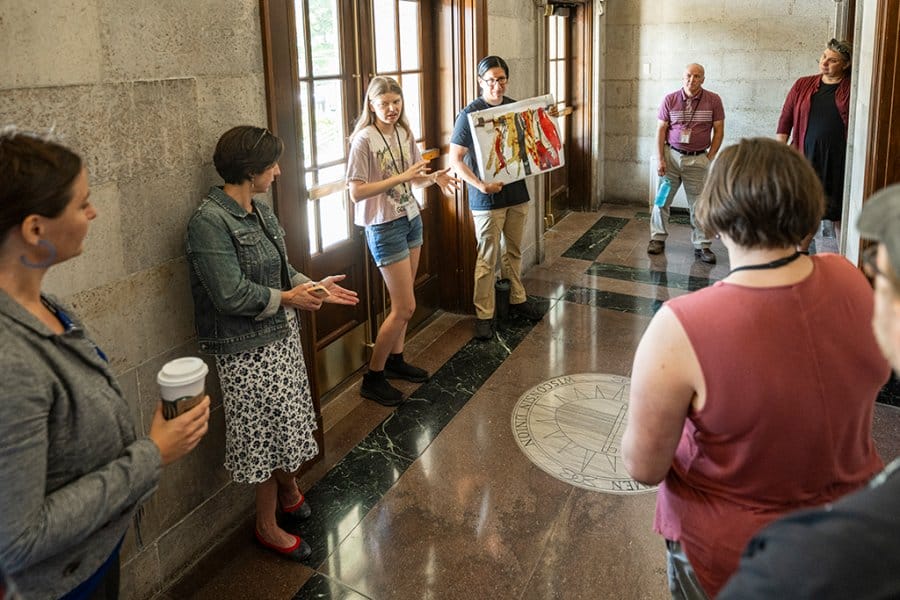
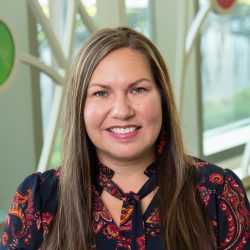
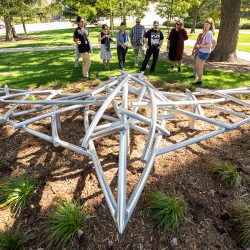

Comments
Karen Frank Barney March 5, 2024
Very important history! I wish I had known this as an undergrad in the ’60s and a grad student in the ’70s!
Ted Bilek (BBA '78, MBA '80) March 5, 2024
This was a good article. Thank you for writing it. I knew that there were mounds on campus, but I did not realize the depth of the history. This is an important program.
The article was good, but it made me want more. What you did not provide in the write-up was information on how often (and when) these tours go out, how long they usually last, and how one can sign up for them. I believe that at least a web link would have been a good addition for those wanting further information.
Thank you again for writing this.